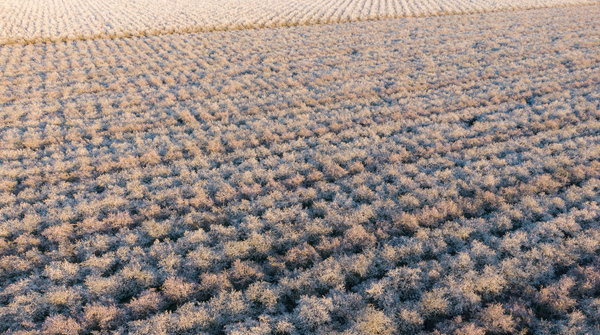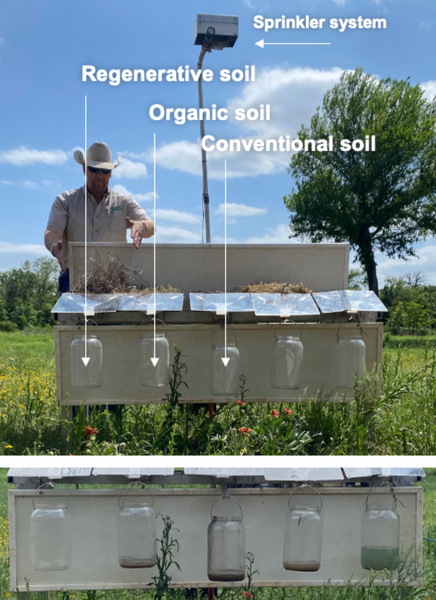Sep 18, 2023
Almonds aren’t as thirsty as you’ve been told.

An aerial view of the orchards at Treehouse Almonds
Over the last several years of building a deep relationship with Treehouse Almonds, our partner in The Almond Project, we’ve seen firsthand how generalizations within media coverage have the potential to negatively impact the livelihoods of thousands of families and communities that grow our almonds. You’ve probably read (or heard about) the article about how it takes 1 gallon of water to grow every almond. While this is true, it simplifies a complex story into a thirsty headline to attract clicks, giving almond farming a bad reputation for water usage.
While admittedly this blog is all about adding context to the relationship between water and almonds and how regenerative practices further support efficient water use, the most important thing we've learned through this experience is that everything is most certainly not what it seems on the surface and that there is so much to gain from listening, learning, being curious and going deeper.....now for the real real on almonds and water.
Not a drop goes to waste.
For starters, it takes no more water to grow an almond than it does to grow other tree crops like pistachios and peaches. Contrary to what the article implies, almonds are not even close to the thirstiest tree nut. Walnuts, for instance, drink up 5 gallons of water per nut! Meanwhile, each and every gallon of water used in almond farming produces not just one, but four crops: the almond, the hull, shell, and the tree, all of which are used productively.
The almond industry likes to think of their water usage as “four crops for every drop.” We’ll start with the nut, which is ounce-for-ounce the tree nut highest in protein, fiber, calcium, vitamin E, riboflavin, and niacin. Then you have hulls, which are sold into livestock feed. We've pulled a visual directly from the Almond Board of California to illustrate how much water using the hulls this way saves annually.

Graphic © Almond Board of California
The shells are often sold to the animal industry as cattle bedding, and more recently has been used for biofuel regeneration. And last, but certainly not least, the trees. Almond trees grow for an average of 20-25 years, sequestering carbon from the atmosphere the whole time. In total, almond trees in California alone pulled 30 million metric tons of CO2 from the atmosphere. That’s equivalent to the annual emissions of 6.6 million cars!
Fun fact, 90% of the almond growers in California are family farms, most of which are 100 acres or less.
There are roughly 1.6M acres in CA devoted to almond farming, which happens to be larger than the entire state of Delaware! Now, think about how many communities this industry supports. Fun fact, 90% of the almond growers in California are family farms, most of which are 100 acres or less. The California almond industry respects the need to manage and share the state’s limited water resources, which is the reason they’ve invested in one of the most advanced water supply infrastructures in the world. Between the 1990s and 2010, they adopted high efficiency drip and micro sprinkler irrigation systems, which reduced the amount of water it takes to grow a pound of almonds by 33%. The industry is on track to reduce that amount further by an additional 25% by 2025.
Transforming dirt into healthy, living soil.
Water is gold in our changing climate and farmers are always striving for new, innovative ways of using it carefully— it’s in their DNA. This is why farmers who are implementing regenerative practices are so excited by the potential. We’re already two years into an initiative we’re proud partners of called The Almond Project, which works with growers at Treehouse Almonds to integrate a variety of regenerative agriculture soil health practices on 160 acres of almond farmland (80 acres of organic + 80 acres of conventional). These practices include composting, animal integration, cover cropping, whole orchard recycling, and reducing the use of synthetic pesticides, herbicides and fertilizers.

Dr. Jessica Chiartas, Soil Scientist, showing the results of regenerative practices on Treehouse Almonds' soil on a recent visit to the orchard.

Conventional soil (left) compared to regenerative soil as a result of The Almond Project (right).
Composting alone helps almond orchard soils hold onto 20-30% more water, while animal integration improves biodiversity and provides the land with a natural fertilizer. As animals graze on cover crops like prairie grasses and clover, they fertilize the land as they go, helping transform the dirt into healthy, living soil. Then there’s whole orchard recycling, which is the technical term for chipping the tree and incorporating it back into the orchard soil. Remember those ~25 years of carbon sequestration that happens as the trees grow and live? That carbon goes directly back into the orchard as the chips are added to the soil, which improves water holding capacity by over 30% and increased yield in the next orchard. The Almond Project has implemented all of these practices and will be measuring the improvement in soil and its water holding capacity in years 2024 and 2026 to compare to the 2021 baseline.
And it can take a staggering 100 years to rebuild just one inch of that precious topsoil!
Nothing illustrates this easier than a recent rainwater demonstration comparing regenerative soil with conventional and organic soils— see it for yourself here. In the demonstration, water falls overtop pans of different soils to demonstrate water holding capacity. You can see how the regenerative soil held all of its “rainwater” where the organic and conventional soils showed significant runoff. Runoff is just a nicer way to talk about erosion, or a total loss of topsoil. And it can take a staggering 100 years to rebuild just one inch of that precious topsoil! Just imagine the effect regenerative practices can have on that 1.6 million acres of soil.
Creating healthy, living soil using regenerative practices is a huge step in reducing the amount of water used to grow almonds. Family owned farms, like Treehouse Almonds, who are leading The Almond Project, have already seen vast improvements in their soil. Joe Gardiner of Treehouse says it best. “These practices are not super difficult, but they’re different.” Joe and his family have shown their dedication to furthering the reduction of water usage by taking a chance on regenerative practices in their own orchards. It was a brave step for them, and as Joe says, “nothing inspires change like success.” We’re blown away at the level of care, ingenuity and consideration that our Treehouse family put into stewarding the land for the greater impact of their communities and of the planet. And this spirit is alive in so many farmers!
These practices are not super difficult, but they’re different.
At the end of the day, Cappello’s is here to nurture people AND planet. We’re passionate about regenerative agriculture in almond farming for many reasons, and water usage remains a top priority. There’s no denying that our climate is changing, which means more unpredictable weather, but with regenerative practices we can support efficient use of water that will mitigate the impact of climate change on our soil, orchards, and the communities that nurture them. We’re investing in regenerative almond farming because it’s our responsibility to ensure a thriving food system for future generations, one almond at a time.

Co-founders of Cappello's, Ben Frohlichstein and Stacey Marcellus, with Joe Gardiner of Treehouse Almonds (middle)
